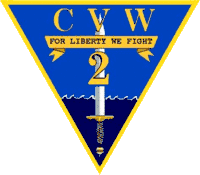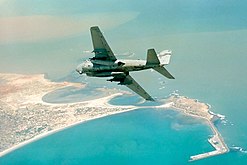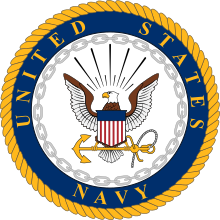Carrier Air Wing Two
Carrier Air Wing Two (CVW-2) is a United States Navy aircraft carrier air wing based at Naval Air Station Lemoore. The air wing is attached to the aircraft carrier USS Carl Vinson (CVN-70).
| Carrier Air Wing Two | |
|---|---|
 CVW-2 Insignia | |
| Active | 1 May 1945 – Present |
| Country | |
| Branch | |
| Type | Carrier Air Wing |
| Garrison/HQ | Naval Air Station Lemoore |
| Motto(s) | "For Liberty, We Fight" |
| Tail Code | NE |
| Decorations | Navy Unit Commendation Armed Forces Expeditionary Medal Meritorious Unit Commendation |
| Battle honours | Korean War Vietnam War Iranian Hostage Crisis Operation Southern Watch Operation Iraqi Freedom |
| Commanders | |
| CMDCM | R. T. McClain |
Subordinate units
CVW-2 consists of 9 Squadrons[1]
| Code | Insignia | Squadron | Nickname | Assigned Aircraft |
|---|---|---|---|---|
| VFA-2 | Strike Fighter Squadron 2 | Bounty Hunters | F/A-18F Super Hornet | |
| VFA-113 | Strike Fighter Squadron 113 | Stingers | F/A-18E Super Hornet | |
| VFA-147[2] | Strike Fighter Squadron 147 | Argonauts | F-35C Lightning II | |
| VFA-192 | Strike Fighter Squadron 192 | Golden Dragons | F/A-18E Super Hornet | |
| VAW-113 | Carrier Airborne Early Warning Squadron 113 | Black Eagles | E-2C Hawkeye | |
| VAQ-136 | Electronic Attack Squadron 136 | Gauntlets | EA-18G Growler | |
| VRC-30 | Fleet Logistics Support Squadron 30 Det. 2 | Providers | C-2A Greyhound | |
| HSC-4 | Helicopter Sea Combat Squadron 4 | Black Knights | MH-60S Seahawk | |
| HSM-78 | Helicopter Maritime Strike Squadron 78 | Blue Hawks | MH-60R Seahawk |
History
1940s-50s
Originally established as CVBG-74 (Battle Air Group) on 1 May 1945, it was renamed CVBG-1 on 15 November 1946 before finally being renamed CVG-2 in 1948[3]. During that time, CVG-2 was assigned to USS Midway (CVB-41). CVG-2 later would see action during the Korean War onboard the Essex class carriers USS Boxer, Valley Forge and Philippine Sea[4]. During the war, they supported the Inchon Invasion, bombing of North Korea occupied Seoul and the recapture of Kimpo Airfield. Starting in 1958, the squadron started a 8 year association with the USS Midway which ended in 1966[4].
1960s
_off_Vietnam_in_1965.jpg)
In 1961, the first A4D-2 (A-4B) Skyhawks to join CVW-2 came aboard during a deployment in the Taiwan Strait during tensions between the two chinas (People's Republic of China and 'Republic of China' on Taiwan). In late 63', CVG-2 made their first deployment with the new F-4H-1F (F-4B) Phantom II with VF-21[4].
It during the first deployment to the Vietnam War that VF-21 as part of the renamed CVW-2 scored the first air to air kills of Vietnam War[5]. In a first for CVW-2, the air wing deployed with the F-4 as the only fighter aircraft onboard as well as the E-2A Hawkeye joining the air wing. It was in 1967 that CVW-2 began their long assignment to the USS Ranger (CV/A-61) which would last till the Ranger's retirement in 1993 (excluding the mid 80s)[6]. With the new A-7A Corsair II and A-6A Intruder, they became the first all jet Attack Carrier Air Wing. CVW-2 spent thirty days in the Sea of Japan due to seizure of the USS Pueblo (AGER-2)[3].
1970s
In December 1972 during their last deployment in the Vietnam War, CVW-2's squadrons introduced Laser-guided bombs into Navy combat service with VA-145 destroying fourteen out of fifteen targeted bridges in under 3 hours[3]. CVW-2 was renamed from Attack Carrier Air Wing Two to Carrier Air Wing Two due to the addition of Anti-submarine warfare units including VS-28 flying the S-3A Viking and HS-14 flying the SH-3D Sea King helicopter[3].
1980s
Starting in 1980, the first F-14A Tomcat squadrons VF-1 and VF-2 were assigned to CVW-2, replacing VF-154 and VF-21 both flying the F-4J Phantom[6]. Between 1982 and 1986, CVW-2 was reassigned to the USS Kitty Hawk (CV-63) making one deployment to the West Pacific and Indian Ocean[6]. In May 1986, CVW-2 returned to the Ranger[6]. Starting between 1986 and 1993, CVW-2 was nicknamed the "Grumman Air Wing" due to lack of a light attack squadron flying either the A-7E Corsair II or the newer F/A-18A Hornet. The only change made was with the newer VA-155 replacing the USMC squadron VMA(AW)-121 in 1990[7].
1990s
With the invasion of Kuwait by Iraq on 2 August 1990, USS Ranger and CVW-2 deployed on 8 December to take in Operation Desert Shield, transiting the Strait of Hormuz on 15 January 1991[3]. At around 4:00AM on 17 January 1991, while USS Midway's air wing were striking targets in Iraq on the first night of the war, the "William Tell Overture" was broadcast around the Ranger as CVW-2 launched to strike targets that morning. During the strike, CVW-2's aircraft struck the port of Umm Qasr and the Mina al-Bakr oil terminal with cluster bombs[8]. For the next 75 hours, they flew more strike missions against Iraqi military targets. During war, the "Grumman Air Wing" was well suited as the primary night Air Wing, with 75 percent of their 10,500 hours being flown at night. With the war over in February 1991, the Ranger and CVW-2 returned to San Diego on 8 June 1991[3].

In 1992, after take in Operation Southern Watch, CVW-2 sailed to Somalia becoming the first Air Wing to take part in Operation Restore Hope, providing air coverage for ground forces and controlling all air traffic into the capital of Mogadishu[3].
In early 1993, VA-155, VF-1 and USS Ranger were decommissioned followed by VA-145 as the A-6E TRAM Intruder was being retired from Navy service[6]. During that time, CVW-2 moved the USS Constellation CV-64 and became the first 50 Strike Fighter Air Wing in the US Navy[3]. Between 1995 and 1997, CVW-2 deployed also with a detachment from VQ-5 flying the ES-3A Shadow based on the S-3 Viking[6].
2000s
During its 2004–2005 deployment, Carrier Air Wing Two executed 4400 fixed-wing sorties for a total of 7588 flight hours, as well as 1518 rotary-wing sorties for a total of 4401 flight hours. The air wing also completed 4455 flight deck landings (traps) while also flying 1737 humanitarian relief missions in support of Operation Unified Assistance between 26 December 2004 and 3 February 2005.[9][10]
During its 2006 deployment, Carrier Air Wing Two participated in three major exercises (i.e., Foal Eagle 06, Valiant Shield 06, RIMPAC 06), and its aircraft flew 7,871 sorties, with a total of 7,578 catapult launches from the flight deck of the Abraham Lincoln.[9][11][12] Between 24–31 March 2006, during Foal Eagle 2006 exercises, strike squadrons VFA-2, VFA-34, VFA-137, and VFA-151 from Carrier Air Wing Two teamed with U.S. Air Force aircraft from the 18th Wing based at Kadena Air Base to provide combat air patrols and coordinated bombing runs via the exercise's Combined Air Operations Center.[13]
During its 2008 deployment, Carrier Air Wing Two flew approximately 7,100 sorties, totaling more than 22,000 flight hours, which included 2,307 combat sorties that dropped 255,963 pounds (116,102,863.8 kg) of ordnance in support of Operation Enduring Freedom – Afghanistan (OEF-A) and Operation Iraqi Freedom (OIF) as a part of the U.S. Fifth Fleet.[14]
2010s
When Abraham Lincoln began its Refueling and Complex Overhaul in 2013, CVW-2 was reassigned to USS Ronald Reagan (CVN-76). It made only a short deployment aboard Ronald Reagan during exercise RIMPAC between June and August 2014, before the carrier was stationed in Japan. CVW-2 then accompanied USS George Washington (CVN-73) for her voyage around South America from September to December 2015.[6]
In 2016, CVW-2 was reassigned to USS Carl Vinson. The wing made its next deployment to the Western Pacific aboard Carl Vinson from 23 January to 23 June 2017.[15]
On 5 January 2018, CVW-2 left San Diego aboard Carl Vinson for another scheduled deployment to the Western Pacific.[16] Carl Vinson returned to San Diego on 12 April 2018.
Current force
Fixed-wing aircraft
- F/A-18E/F Super Hornet
- F-35C Lightning II
- E/A-18G Growler
- E-2C Hawkeye
- C-2 Greyhound
Rotary-wing aircraft
- MH-60R Seahawk
- MH-60S Seahawk
See also
- List of United States Navy Carrier air wings
- History of the United States Navy
References
- "Carrier Air Wing Composition" (PDF). US Navy. Tailhook Association. Archived from the original (PDF) on 21 February 2007. Retrieved 29 December 2006.
- | https://www.ainonline.com/aviation-news/defense/2019-03-01/f-35c-achieves-ioc-singapore-details-initial-f-35-buy
- "CVW-2 Global Security". Globalsecurity. Archived from the original on 10 January 2019.
- "CVG-2". www.gonavy.jp. Retrieved 1 July 2020.
- "USS Midway Air-to-Air Victories in Vietnam". www.midwaysailor.com. Retrieved 1 July 2020.
- "CVW-2 (NE)". CVW-2 (NE): 1963 – present. GoNavy.jp. 3 February 2017. Retrieved 3 February 2017.
- Rogoway, Tyler. "The USS Ranger Sailed With A Unique "Grumman Air Wing" In The Mid 1980s". The Drive. Retrieved 1 July 2020.
- Pokrant, Marvin (1999). Desert Storm at Sea: What the Navy Really Did. Greenwood Publishing Group. ISBN 978-0-313-31024-9.
- "USS Abraham Lincoln (CVN-72): 2004 Operations". Dictionary of American Naval Fighting Ships. Navy Department, Naval History and Heritage Command. Retrieved 21 December 2010.
- John M. Daniels (2004). "2004 Command History: USS Abraham Lincoln CVN-72" (PDF). Naval History & Heritage Command. Archived from the original (PDF) on 31 January 2012. Retrieved 24 December 2010.
- Mass Communication Specialist 1st Class (SW) Joaquin Juatai, USN (8 August 2006). "Abraham Lincoln Wraps Up Deployment 2006". NNS060808-07. USS Abraham Lincoln Public Affairs. Retrieved 24 December 2010.
- Mass Communication Specialist 1st Class Bruce McVicar, USN (11 August 2006). "Naval Station Everett Celebrates Return of Ships". NNS060811-07. Naval Station Everett Public Affairs. Retrieved 26 December 2010.
- Photographer's Mate 3rd Class (AW) M. Jeremie Yoder, USN (27 March 2006). "Lincoln Wraps Up Successful Exercise, Heads for Port". NNS060406-15. Abraham Lincoln Public Affairs. Retrieved 26 December 2010.
- Mass Communication Specialist 3rd Class Brandon C. Wilson and Mass Communication Specialist 3rd Class Geoffrey Lewis (15 October 2008). "USS Abraham Lincoln Returns Home After Successful Deployment to 5th, 7th Fleets". NNS081015-01. USS Abraham Lincoln Public Affairs. Retrieved 27 December 2010.
- USS Carl Vinson (CVN 70) Public Affairs (5 January 2017). "Carl Vinson Carrier Strike Group Begins Western Pacific Deployment". NNS170105-04. USS Carl Vinson (CVN 70) Public Affairs. Retrieved 3 February 2017.
- Carrier Strike Group 1 Public Affairs (5 January 2018). "Carl Vinson Strike Group Departs for Deployment to Western Pacific". NNS180105-11. Carrier Strike Group 1 Public Affairs. Retrieved 6 January 2017.
External links
- Carrier Air Wing Two (official site)
